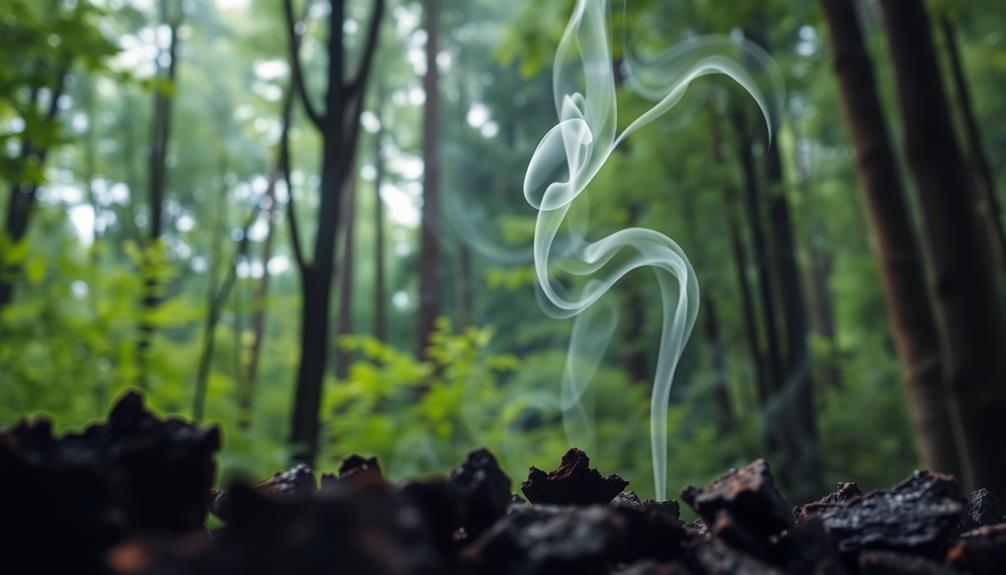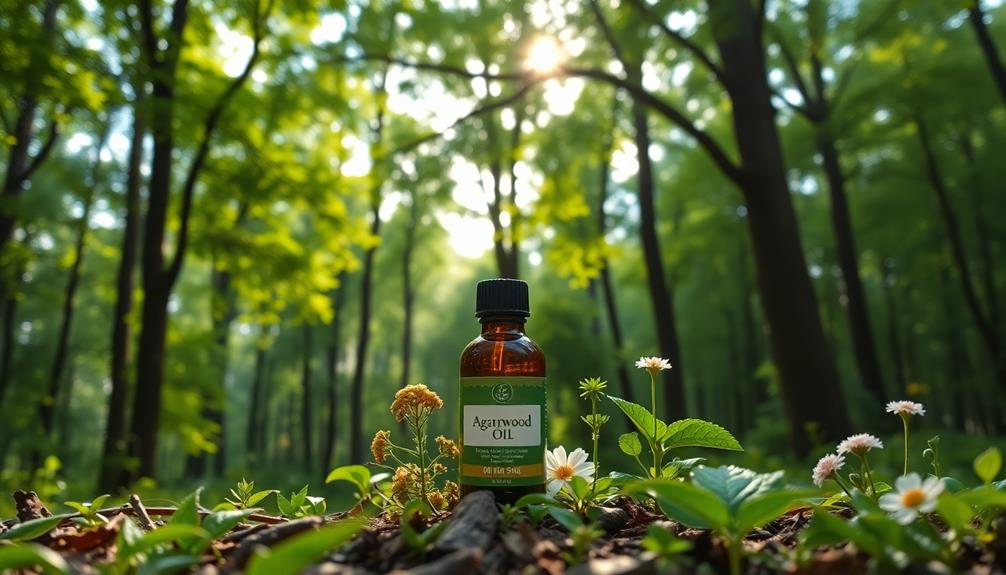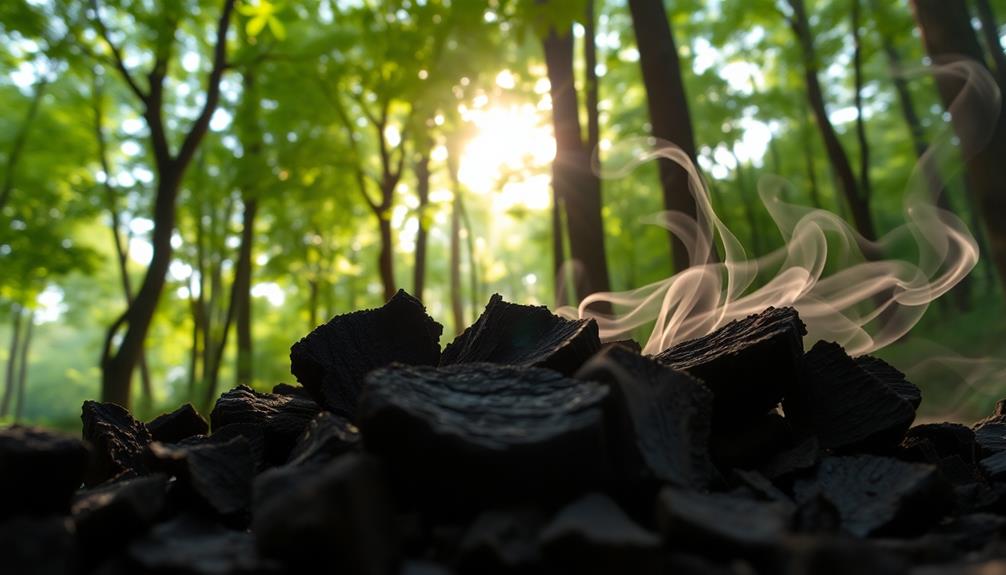Agarwood smells incredible, combining warm, woody, sweet, and spicy notes that instantly captivate you. This unique fragrance often feels comforting and rich, bringing images of serene forests to mind. You might notice earthy undertones, with hints of citrus or nuttiness, depending on the type of agarwood. It's used in incense and perfumes, filling a space quickly and creating a lovely atmosphere. Some people find it reminiscent of other scents, so be aware it can change based on your mood. If you're curious about how to experience agarwood in different ways, there's more to explore!
Key Takeaways
- Agarwood has a captivating fragrance with a blend of woody, sweet, spicy, and leathery notes that evoke nostalgia and spirituality.
- The scent varies by species; Aquilaria crassna offers a sweeter aroma, while Aquilaria malaccensis tends to have earthy and medicinal undertones.
- Burning agarwood releases a rich, vanillic woody aroma that quickly fills a space, creating an immersive sensory experience.
- The aroma includes warm, resinous qualities along with hints of citrus, nuttiness, and earthy undertones, reminiscent of serene forest environments.
- Some individuals may perceive agarwood's scent as similar to burning plastic or decomposed materials, highlighting its complex nature.
Introduction

Agarwood, often referred to as oud, offers a captivating fragrance that draws you in with its unique blend of woody, sweet, spicy, and leathery notes. This complex fragrance creates an experience that's both warm and earthy, making it truly special.
When you encounter agarwood, you might notice how its scent can evoke feelings of nostalgia and even spirituality. It often depends on how you feel at the moment.
Different species of Aquilaria trees produce distinct aromas. For instance, Aquilaria crassna brings out a sweet and woody scent, while Aquilaria malaccensis offers earthy, medicinal notes.
When you burn agarwood, you can expect a rich, vanillic woody aroma that fills a space quickly, detectable within a short range. The aroma profile is diverse, featuring hints of citrus, nutty, camphoraceous, and spicy elements.
These layers contribute to agarwood's luxurious reputation in perfumery. You'll find that this aroma isn't just a scent; it's an invitation to explore a world of rich experiences.
Description of the Smell

The scent of agarwood is a mesmerizing blend that envelops you in its warm, resinous embrace. When you take a moment to breathe in, you'll notice how agarwood smells rich and inviting, with a complex aroma that combines woody, sweet, and spicy notes. The depth of the scent unfolds gradually, revealing hidden layers that captivate the senses with every inhale. Beyond its initial woody intensity, it’s easy to detect subtle hints reminiscent of *rosewood fragrance characteristics*, adding an elegant, floral nuance to the composition. This interplay of elements creates a harmonious balance that lingers beautifully in the air. As the scent evolves, you may also detect earthy undertones that ground the fragrance, further enhancing its allure. These earthy notes, combined with the distinctive **cedarwood aromatic profile**, introduce a dry, slightly smoky warmth that complements the richer, spicier facets of agarwood. It’s this seamless fusion of complexity and subtlety that makes agarwood an unforgettable sensory experience.
This unique fragrance also carries earthy undertones that can transport you to a serene forest. As you explore deeper, hints of citrus and nutty scents might surprise you, while camphoraceous and floral notes add a delightful twist.
Depending on the species of Aquilaria tree, the aroma can vary. For instance, Aquilaria crassna offers a sweeter smell, whereas Aquilaria malaccensis has a more medicinal and earthy scent.
When you burn agarwood incense, its woody aroma fills a space quickly, spreading within five minutes and creating an immersive experience. You might feel nostalgic or spiritually connected, but some could find the smell reminiscent of burning plastic or decomposed materials.
Source and Composition

Originating from the resinous heartwood of Aquilaria trees, agarwood, also known as oud, develops its enchanting aroma as a response to fungal infection. This unique process gives agarwood its rich scent, which varies depending on the specific species of Aquilaria and where it's grown.
For instance, Aquilaria crassna offers a sweet and woody aroma, while Aquilaria malaccensis has a more medicinal and earthy scent.
When you explore the scent of agarwood, you'll discover its complexity and depth. You might notice warm, woody notes paired with sweet, earthy, and musky undertones.
It can also surprise you with hints of spiciness, fruitiness, and even floral or nutty aromas.
The extraction process of agarwood oil is equally fascinating. Using steam distillation or CO2 methods, this oil captures the essence of the resinous heartwood.
It contains sesquiterpenes that enhance the multifaceted scent of agarwood. So, whether you're using it in perfumes or incense, you'll appreciate the layers of fragrance it brings to your experience.
Enjoy the journey into the aromatic world of agarwood!
Typical Scenarios or Environments

In various settings, agarwood's enchanting aroma transforms the atmosphere, inviting relaxation and introspection. You might find that the agarwood smell fills a room quickly, perfect for creating a warm and welcoming environment.
In meditation or yoga classes, this aromatic substance can enhance your focus and promote relaxation, making your practice even more meaningful.
You'll often experience agarwood during religious and spiritual ceremonies, where its rich, earthy scent adds depth to the rituals. The warm, spicy notes of agarwood can create a special ambiance, helping everyone feel more connected during these sacred moments.
In Middle Eastern cultures, agarwood is prized as a perfume ingredient, creating luxurious scents that elevate intimate gatherings or celebrations.
When you light agarwood incense, the fragrance swirls around, enriching the atmosphere and creating a sensory experience you won't forget.
Emotional or Cultural Associations

Agarwood's captivating aroma brings forth a wave of nostalgia and spiritual connection for many, enhancing moments of meditation and reflection. When you inhale its warm, woody, and sweet scent, you might feel a sense of calm wash over you. This is because agarwood has unique calming properties that promote emotional well-being, helping to alleviate stress and anxiety.
In cultures around the world, especially in the Middle East, agarwood carries significant cultural importance. It symbolizes luxury and refinement, often used in traditional ceremonies and rituals. The Quran even mentions it as aloe wood, highlighting its spiritual significance in Islamic traditions and its role in purifying rituals.
With its diverse scent profile featuring spicy, sweet, and earthy notes, agarwood creates a multisensory experience. This richness can remind you of lush gardens and natural landscapes, deepening your connection to nature.
As you explore agarwood, you might find that it not only enhances your personal rituals but also connects you to a broader cultural heritage, making each moment spent with its scent truly special.
Health or Safety Considerations

When using agarwood products, it's essential to consider health and safety precautions to ensure a pleasant experience. The oil and the smell of Oud have been used for centuries, but they can pose some risks. If you have asthma or any respiratory conditions, be careful! The smoke from burning agarwood incense may trigger allergic reactions or worsen your breathing.
When applying agarwood oil, remember to dilute it first. This helps prevent skin irritation since the oil can be potent for some people.
Pregnant or breastfeeding women should consult a healthcare professional before using agarwood products, as there's limited research on their safety during these times.
You might also notice that the pleasant scent of agarwood can be strong. If you're in an enclosed space, it might cause headaches or dizziness, so it's best to use it in well-ventilated areas.
If you're sensitive to the natural smell, consider synthetic oud alternatives. These are commonly used and usually contain fewer allergens and irritants.
Final Thoughts

Embracing the allure of agarwood can transform your sensory experience, offering a rich tapestry of fragrances that captivate the senses. Known as oud, this precious wood has a unique aroma that people around the world cherish.
When the oil is extracted from agarwood, it reveals a scent that's woody, sweet, spicy, and earthy. You might describe the scent as warm and resinous, with hints of citrus, nutty, and even floral elements.
Each type of agarwood, like Aquilaria crassna and Aquilaria malaccensis, gives off different notes, enhancing your exploration. Some people find that the fragrance lingers on the skin, creating a personal scent story.
For centuries in religious practices, agarwood has been valued for its calming effects and ability to evoke feelings of nostalgia.
If you're curious, try incorporating agarwood into your meditation or relaxation routines. You'll discover how its rich scent can elevate your experience.
Ultimately, agarwood is more than just a fragrance; it's a journey through time and culture, inviting you to relish each unique note and memory it brings.
Frequently Asked Questions
Does Agarwood Smell Nice?
You might find agarwood's scent nice, as many describe it as warm, woody, and sweet. However, others may disagree, perceiving it differently based on personal experiences and preferences. It's really subjective!
What Is so Special About Agarwood?
Agarwood's special because it's rare, luxurious, and steeped in cultural significance. You'll find it in traditional rituals and high-end perfumes, making it a sought-after treasure that embodies refinement and unique craftsmanship.
Why Is Agarwood Very Expensive?
Agarwood's high price stems from its rarity and lengthy production process. You'll find that overharvesting and illegal logging have drastically reduced tree populations, making this luxurious scent even more sought after and expensive.
What Is the Difference Between Sandalwood and Agarwood?
You'll find that sandalwood offers a creamy, soft scent, while agarwood presents a rich, complex aroma. Agarwood's rarity and intricate production process contribute to its higher price compared to the more accessible sandalwood.









